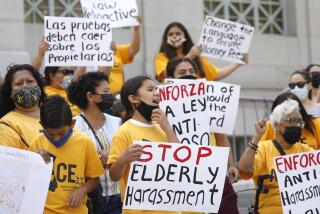Illegal Signs Spur Residents to Take Action
- Share via
Driving along any San Fernando Valley street, you can take in 10, maybe 15 of the signs.
Promoting businesses from real estate to pizza parlors to bellybutton piercing, the ads are usually posted on utility poles or on the sides of buildings.
They are quick and free--but illegal--advertising for small businesses or upcoming events.
But to Sherman Oaks residents, the signs have become a nuisance--to the extent they want to take action themselves.
“I’ve seen signs stay up for weeks and sometimes months after the events are over,” said Sherman Oaks Homeowners Assn. President Richard Close.
The city of Los Angeles, short of money, has only one inspector assigned to the Valley to enforce the sign laws, but he doesn’t work weekends, when real estate signs proliferate. Violators are given a citation that carries a fine of about $100, but the homeowners insist that follow-up is usually inadequate and is not solving the problem.
So after five years of complaining among themselves, homeowners want to literally take the law into their own hands. They are not only offering to supply weekend overtime pay for the city inspector but have assembled their own volunteer force of sign police.
Close said that with city approval, his volunteers would head out on Saturday mornings to comb the streets, rip down signs, and issue citations.
But is it legal for the city to deputize citizens to combat urban blight?
The homeowners sent their proposal to the Los Angeles city attorney’s office May 10, seeking official approval.
Rick Schmidt, supervising attorney for the Van Nuys branch of the city attorney’s office, said his office is still reviewing the proposal.
Schmidt said the central issue is whether the civilian “sign police” would themselves be liable for criminal charges for removing the signs--other people’s property.
With no prior similar civic situations to compare the offer to, Schmidt said his office must carefully review the legal aspects.
Tom Stevens, a principal building inspector in Van Nuys, said the city concedes that homeowners in both Sherman Oaks and Woodland Hills could be helpful in regulating the sign problem.
But he noted that the city’s inspectors occasionally have to go to court to defend their issuance of citations.
If a violator challenged a citation filled out by a homeowner volunteer, the volunteers could not defend their actions in court because they do not legally represent the city, he said.
Stevens also expressed fears that homeowners who also own businesses might possibly target their competitors’ signs, causing ethical difficulties.
“We [city inspectors] are a disinterested public service,” Stevens said. “We have no stake in taking down the signs. I just worry that some people might have a business interest in the issue.”
Stevens said the signs have become a problem in recent years as businesses, some still reeling from the recession, viciously compete for tight customer dollars. They resort to posting the signs, which cost nothing but could make unknown amounts of money.
After meeting with homeowner groups from Sherman Oaks and Woodland Hills, Stevens suggested having the volunteers pass out fliers informing businesses that the signs are illegal and that financial punishment will result if they post them--but to leave the law enforcement to the designated authorities.
More to Read
Sign up for Essential California
The most important California stories and recommendations in your inbox every morning.
You may occasionally receive promotional content from the Los Angeles Times.










